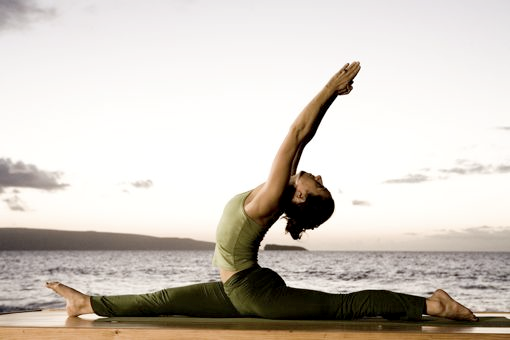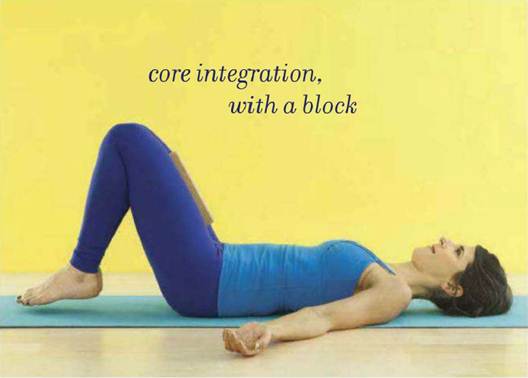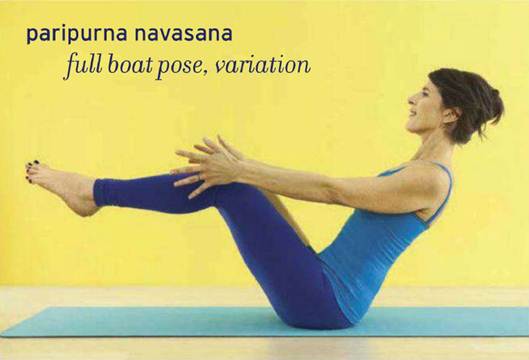Fire up your deep core and inner leg muscles
to build strong abs.
When you see yogis doing an arm balance
with finesse, they look as light as a feather. They make the pose look so easy
that you might forget how much strength it requires. But the inverse is
actually true – to make a difficult pose look effortless, you need to be plenty
strong.
Yoga doesn’t build brute force, it teaches
you to cultivate a different type of strength: the strength that results from
physical integration and connection. Physical integration is that sense of
coordinating different parts of the body so that they work in concert. It’s the
idea that we become exponentially more powerful when the whole body works in
unison rather than when we isolate a muscle or muscle group. When we learn
this, and feel it, we have the powerful and beneficial experience of being
whole.

A key way to learn physical integration is
to work the core abdominal muscles. By simultaneously activating your inner
thighs, your deep abdominal muscles, and your breath, you’ll build integrated
strength that will affect all of your poses.
Action plan
In these poses, you execute three main
actions. You adduct (squeeze together) the inner thighs; engage the transverse
abdominus (a deep abdominal muscle that wraps around the torso from front to
back and from ribs to pelvis); and contract the hip flexors and the rectus
abodominus (a.k.a. your “six pack”).
The end game
By simultaneously engaging your inner
thighs, hip flexors, and abdominals, you will develop greater stability, and
reinforce a feeling of connection throughout your whole body.
Warm-up
These poses can be placed nearly anywhere
in a sequence. You can do them before Surya Namaskar (Sun Salutation) and
standing poses to awaken your midsection and generate heat. You may also put
them in the middle of your practice as a lead-up to arm balances, inversions,
twists, backbends, or forward bends.
After you finish these poses, take Supta
Baddha Knasana (Reclining Bound Angle Pose), with your legs supported, as a
counterpose. Then rest in Savasana (Corpse Pose). Try taking your heels as wide
as your sticky mat to help you release and soften your abdominals and inner
thighs.
1. Core integration with a block

Core
integration with a block
How to
This is not a big pose; its small yet
deeply challenging action will instantly bring attention to the midline of your
body. When you learn to work your inner thighs and your core simultaneously,
you can use the action in many of yoga pose, lending them more strength and
stability. To begin, lie back with your knees bent and your feet on the floor
hip-width apart. Place a block between your thighs. Position it so that the
longest side is parallel to your thigh bones. This will maximize the amount of
contact between your inner thigh and the block. Rest your hands on the floor
comfortably.
Squeeze the block firmly with your inner
thighs and bring your attention to the sensation of your adductors as they
engage. Bring your pelvis into a posterior tilt: Draw your hip point up and
away from the top of your thighs until your lower back touches the floor
lightly. Retain this as you pull your navel toward your spine and feel your
abdominals kick in. you’ll feel a hollow sensation between your navel and
public bone.
Finally, add your hip flexors into the
equation by lifting your feet an inch or 2 off the mat. Lifting your feet
higher is less challenging – if possible, keep your feet hovering just barely
above the floor.
As you sustain the pose for 5 to 10
breaths, continue to squeeze the block firmly, pull your hip points up, and
float your feed a touch above the floor. Then lower your feet to the floor,
relax all effort, and rest for a few breaths before repeating 2 to 3 more
times.
Why this works:
It activates the abdominal muscles and hip
flexors. Squeezing a block between your legs helps you fire up and strengthen
the adductors (inner thighs).
2. Paripurna navasana – full boat pose, variation

Paripurna
navasana – full boat pose, variation
How to
Sit on your sticky mat with your knees bent
and toe tips on the floor. Place the block between your thighs with the longest
side parallel to your inner thighs. Lengthen your spine: Press your fingertips
into the floor behind you, root your sitting bones down, and lift your chest.
Draw your lower belly toward your spine,
squeeze the block, and lift your feet up until your shins are parallel to the
floor. Fell the strong contraction of your inner thighs, hip flexors,, and
abdominals as they fire together and pull toward your center.
Now take your fingertips off the ground and
reach your arms forward with your palms facing each other. Gently draw the
inner borders of your shoulder blades toward your spine to create stability and
awareness in your upper back. If your lower back rounds or your chest drops
when you lift your fingers away from the floor, simple bring inner them back
floor.
Keeping your inner thighs strongly engaged
requires constant attention because the intensity in the front of your thighs
will tend to preoccupy your mind. Squeeze the block enough that you feel the
inner thighs tire at the same rate as your abdominals. After 5 to 6 breaths,
remove the block and lower your feet to the floor. Repeat 2 to 3 times.
Why this works
Squeezing the block strengthens your inner
thighs, complements the work your hip flexors and abdominals are doing; and
focuses your attention on the midline of your body.
3. Forearm plank pose

Forearm
plank pose
How to
To prepare for Forearm Plank, come onto all
flours. Place a block between your thighs and squeeze it. Bring your elbows to
the ground. See that your shoulders are directly above your elbows and your
upper arms are vertical. Align your forearms so that they’re parallel to each
other, with palms facing down.
Lift your knees and straighten your legs.
Step your feet back until your legs, pelvis, torso, and head are all in the
dame horizontal plane. Root firmly into the floor with your forearms, lift the
back of the heart, and broaden your shoulder blades. Fire up your core by
pulling your hip points toward your navel as you lengthen your tailbone toward
your heels, and engage your abdominals muscles. Support these actions by
squeezing the block.
It’s important to be vigilant and
troubleshoot this pose. Notice if you lift your hips too high, roll the front
rim of your pelvis toward the floor, or overarch your lower back. (if you can’t
tell, you can always ask a friend to look at you or snap a quick photo.) Beware
of dropping your head lower than your shoulders. All of these “don’ts” crop up
as your body’s way of compensating for a lack of core strength, they also
prohibit you from getting the full benefit of the pose. To do a pose
successfully rather just survive it, keep your attention on the key actions of
the posture.
After 5 to 6 breaths, slowly lower your
knees to the floor, remove the block, and rest in Balasana (Child’s Pose)
savoring a job well done. Repeat 2 to 3 times.
Why this works
Forearm Plank is more challenging for the
abs and hip flexors than Plank Pose because of pure physics. Your upper body is
closer to the floor in Forearm Plank, which changes the distribution of your
weight and forces you work harder to support yourself. Squeezing the block
between the thighs engages your legs, which helps keep your pelvis and lower
back aligned.